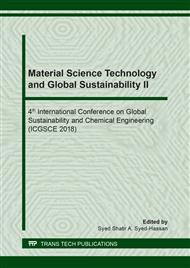[1]
Faisal Abnisa, Wan Mohd Ashri Wan Daud, A review on co-pyrolysis of biomass: An optional Technique to obtain a high-grade pyrolysis oil. Energy Conversion and Management 87(2014) 71-85.
DOI: 10.1016/j.enconman.2014.07.007
Google Scholar
[2]
Jiang Wang, Shou-Yu Zhang, Xi Guo, Ai-xia Dong, Chuan Chen, Shao-wu Xiong, Yi-tian Fang, Wei-di Yin, Thermal Behaviours and Kinetics of Pingshuo Coal/Biomass Blends during Copyrolysis and Cocombustion, energy fuels.
DOI: 10.1021/ef301473k
Google Scholar
[3]
Yuyao Song, Arash Tahmasebi, Jianglong Yu, Co-pyrolysis of pine sawdust and lignite in a thermogravimetric analyzer and a fixed bed reactor, Bioresource Technology 174 (2014) 204-211.
DOI: 10.1016/j.biortech.2014.10.027
Google Scholar
[4]
Xiaohong Li, Yanli Xue, Jie Feng, Qun Yi, Wenying Li, Xiaofen Guo, Ke Liu, Co-pyrolysis of lignite and Shengdong coal direct liquefaction residue, Fuel 144 (2015) 342-348.
DOI: 10.1016/j.fuel.2014.12.049
Google Scholar
[5]
Ryan M. Soncini, Nicholas C. Means, Nathan T. Weiland, Co-pyrolysis of low rank coal and biomass: Product distributions, Fuel 112 (2013) 74-82.
DOI: 10.1016/j.fuel.2013.04.073
Google Scholar
[6]
A. O. Aboyade, J. F. Gorgens, M. carrier, E. L. Meyer, J. H. Knoetze, Thermogravimetric study of the pyrolysis characteristics and kinetics of coal blends with corn and sugarcane residues, Fuel Processing Technology, vol. 106, pp.310-320, (2013).
DOI: 10.1016/j.fuproc.2012.08.014
Google Scholar
[7]
L.G. Wei,L.Zhang,and S.P.Xu,Synergetic effects on tar components from co-pyrolysis of biomass and coal in a free fall reactor,, JournalofFuelChemistryandTechnology,vol.40,p.519–525, (2012).
Google Scholar
[8]
Cui Quan and Ningbo Gao, Copyrolysis of Biomass and Coal: A Review of Effects of Copyrolysis Parameters, Product Properties, and Synergistic Mechanisms, HindawPublishing Corporation BioMed Research International, Volume 2016, Article ID 6197867, 11 pages.
DOI: 10.1155/2016/6197867
Google Scholar
[9]
Aime Hilaire Tchapda and Sarma V. Pisupati, A Review of Thermal Co-Conversion of Coal and Biomass/Waste, Energies 2014, 7, 1098-1148.
DOI: 10.3390/en7031098
Google Scholar
[10]
L.Zhang,S.Xu,W.Zhao,andS.Liu,Co-pyrolysis of biomass and coal in a free fall reactor,, Fuel, vol. 86, no. 3, p.353–359, (2007).
DOI: 10.1016/j.fuel.2006.07.004
Google Scholar
[11]
J.-Y. Lee, C. Yoo, S.-Y. Jun, C.-Y. Ahn, and H.-M. Oh,Comparison of several methods for effective lipid extraction from microalgae,, Bioresource Technology,vol.101,no.1,pp.S75–S77, (2010).
DOI: 10.1016/j.biortech.2009.03.058
Google Scholar
[12]
Akinwale O. Aboyade, Marion Carrier, Edson L. Meyer, Hansie Knoetze ,Johann F. Görgens, Slow and pressurized co-pyrolysis of coal and agricultural residues, Energy Conversion and Management 65 (2013) 198–207.
DOI: 10.1016/j.enconman.2012.08.006
Google Scholar
[13]
M. Guo and J.-C. Bi, Characteristics and application of co-pyrolysis of coal/biomass blends with solid heat carrier,, Fuel Processing Technology, vol.138, p.743–749, (2015).
DOI: 10.1016/j.fuproc.2015.07.018
Google Scholar
[14]
Francesca Ferrara, Alessandro Orsini, Alberto Plaisant, Alberto Pettinau, Pyrolysis of coal, biomass and their blends: Performance assessment by thermogravimetric analysis, Bioresource Technology 171 (2014) 433–441.
DOI: 10.1016/j.biortech.2014.08.104
Google Scholar
[15]
S. Yuan, Z.-H. Dai, Z.-J. Zhou, X.-L. Chen, G.-S. Yu, and F.C. Wang, Rapid co-pyrolysis of rice straw and a bituminous coal in a high-frequency furnace and gasification of the residual char,, Bioresource Technology, vol.109, p.188–197, (2012).
DOI: 10.1016/j.biortech.2012.01.019
Google Scholar
[16]
A.-G. Collot, Y. Zhuo, D. R. Dugwell, and R. Kandiyoti, Copyrolysis and co-gasification of coal and biomass in bench-scale fixed-bed and fluidized bed reactors,, Fuel, vol.78, no.6, p.667–679, (1999).
DOI: 10.1016/s0016-2361(98)00202-6
Google Scholar
[17]
Navirin Vhathvarothai, James Ness and Qiming J. Yu, An investigation of thermal behaviour of biomass and coal during copyrolysis using thermogravimetric analysis, International Journal of Energy research, 214; 38:1145-1154.
DOI: 10.1002/er.3120
Google Scholar
[18]
Wang Y, Li X, Mourant D, Gunawan R, Zhang S, Li C-Z. Formation of aromatic structures during the pyrolysis of bio-oil. Energy Fuels 2012; 26:241–7.
DOI: 10.1021/ef201155e
Google Scholar
[19]
Yi Wang, Xun Hu, Daniel Mourant, Yao Song, Lei Zhang, Caroline Lievens, Chun-Zhu Li, Jun Xiang, Evolution of aromatic structures during the reforming of bio-oil:Importance of the interactions among bio-oil components, Fuel 111 (2013) 805–812.
DOI: 10.1016/j.fuel.2013.03.072
Google Scholar
[20]
Zhe Xiong, Yi Wang, Syed S.A. Syed-Hassan, Xun Hu, Hengda Han, Sheng Su, Kai Xu, Long Jiang, Junhao Guo, Engamba Esso S.B. , Song Hu, Jun Xiang, Effects of heating rate on the evolution of bio oil during its pyrolysis, Energy Conversion and Management 163 (2018) 02-078.
DOI: 10.1016/j.enconman.2018.02.078
Google Scholar
[21]
Junqing Cai, Yiping Wang, Limin Zhou, Qunwu Huang, Thermogravimetric analysis and kinetics of coal/plastic blends during co-pyrolysis in nitrogen atmosphere, Fuel Processing Technology 89 (2008) 21– 27.
DOI: 10.1016/j.fuproc.2007.06.006
Google Scholar
[22]
Liu W-J, Tian K, Jiang H, Zhang X-S, Yang G-X, Preparation of liquid chemical feedtocks by co-pyrolysis of electronic waste and biomass without polybrominated dibenzo-p-dioxins. Bioresources Technology 128 (2013) 1-7.
DOI: 10.1016/j.biortech.2012.10.160
Google Scholar
[23]
Zhang L, Xu S, Zhao W, Liu S. Co-pyrolysis of biomass and coal in a free fall reactor. Fuel 86 (2007) 353–9.
DOI: 10.1016/j.fuel.2006.07.004
Google Scholar
[24]
Majorie Ruth Rover, Analysis of sugars and phenolic compounds in bio oil, PhD thesis IOWA State University, 2013, supervised by Robert C. Brown.
Google Scholar
[25]
T. Codero, J. Rodriguez-Mirasol, J. Pastrana and J. J. Rodriguez,Improved solid fuels from co-pyrolysis of a high sulphur content coal and different lignocellulosic wastes, ,Fuel, vol. 83, no 11-12, pp.1585-1590, (2004).
DOI: 10.1016/j.fuel.2004.02.013
Google Scholar
[26]
C.-Z. Li, C. Sathe, J.R. Kershaw, Y. Pang, Fates and roles of alkali and alkaline earth metals during the pyrolysis of a Victorian brown coal, Fuel 79 (2000) 427–438.
DOI: 10.1016/s0016-2361(99)00178-7
Google Scholar



